Exterior Painting Color Combinations
Explore 10 different and timeless exterior painting color combinations. Discover the color combinations that fit your home’s style. Is your home on the traditional side or is it modern or contemporary?
Knowing the style of your home can help you determine the exterior color combinations that suit it.
10 Trendy Paint Schemes for Your House Exterior
A home’s exterior provides that first impression. Real estate owners will often tell you that potential house buyers are all about curb appeal because when you don’t entice them on the outside, how will they care to see what’s on the inside? Even if you don’t have any plans to sell your house in the future, having a beautiful and appealing exterior is still part of an owner’s responsibility.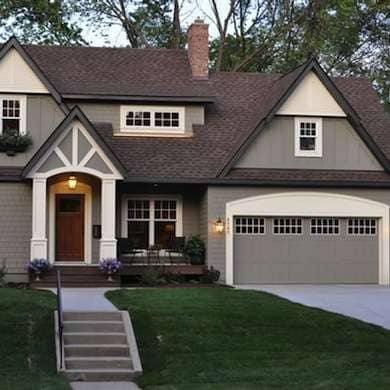
One of the best ways to improve curb appeal is through exterior painting. While there are different color trends for the interior, it’s good to know that trends for exterior color schemes are far more timeless and can take a while before a new one rolls in. The key to finding a good color scheme for a house is to look at its style. Is it traditional? Is it gearing towards modern? Or is the style more contemporary? Knowing the style of your house, what defining features make it and the history behind it should let you know which color schemes to choose. Have a look at five of the most loved house styles in America below and the color schemes that go well with it.
Exterior Painting Color Combinations for a Colonial Style Home
What it is: America’s darling home traces its roots back to the colonial period (16th to 19th century) of the United States. It conjures up images of 4th of July and village greens with children and grownups running around defining the independent spirit of America. Colonial homes are perennial, still seen all over the cities and states of the US. It is further classified into French Colonial, Dutch Colonial, Spanish Colonial, First Period and Colonial Georgian. European settlers brought in all styles during their colonization of America.
Defining Features: Colonial homes are the houses that were etched into our minds as children: square or rectangular bodies with a triangular roof, a centrally placed door with windows on both sides and a chimney. Although there are different types of colonial architecture, all houses share the same characteristics with a few differences based on geographic location.
- Symmetrical Structure – Colonial homes are very symmetrical mostly in square or rectangular shape with wood sidings or brick. There are a few embellishments and the exterior is kept simple save for a few architectural details. Chimneys completed the look to provide warmth and heat during the colder months.
- Balanced Window Placement – Some homes have two on one side and one on the other and some will have equal placements with one or two on either side. Decorative shutters are used as accents and most colonial homes have evolved to accommodate a bay window.
- Pitched Roof – Most Colonial homes have heavily pitched roofs, which serve the purpose of shedding snow during winter. In the South where the winds are stronger, hip roofs that have four sloping sides replaced the gable roofs to provide more protection from winds and hurricanes.
- Decorative Front Entrances – Colonial homes placed focus and attention to entries. Doors are paneled adorned with a pediment sometimes extended to create a small roofed porch supported with columns or pilasters.
Dominant Colors: Colonial homes relied heavily on modest earth tone colors such as creamy off-white, pale yellow, reddish-brown, beige, taupe and pale green. These were colors that were easy to come up with because the pigments were naturally sourced and depending on the region, different mixers were used and therefore colors varied per area.
Modern Color Trends:
- White Siding + white trims + black door and/or shutters – A true classic that pays homage to the true roots of the American Colonial Home, white is always elegant and timeless. You can choose from a crisp white color or a creamy white with a tinge of yellow. Black is the best go-to-color pairing with white but since white is versatile; other darker accents can be used.
- Dove gray siding + white trims + dark gray or white shutters + red or dark gray door – Another one of the timeless
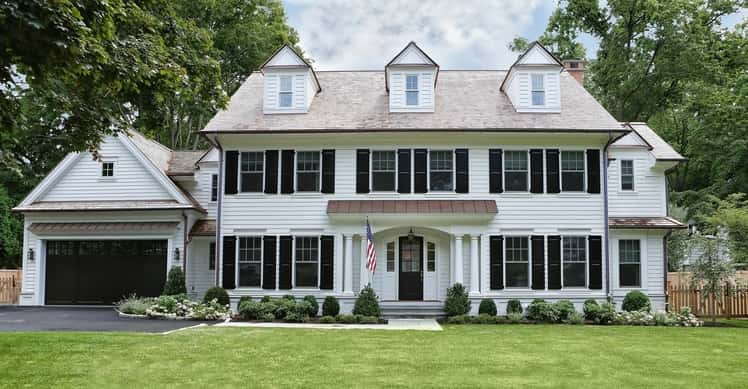
Exterior Painting Color Combinations.
color, gray seems to be popular in or outside of the house whether it’s dark or light. Since the colors are monochrome, a brighter accent like bright red or a warm brown-red can be used for the door.
Exterior Painting Color Combinations for Cape Cod Style Homes
What it is: Originating from Cape Cod, Massachusetts from where it got its namesake, the Cape Cod house was built to withstand the harsh winds and cold weather in winter. It was built with locally sourced materials; wood covered in clapboard sidings and left unpainted. The original Cape Cod was simple and minimalist in nature with very little embellishments that later on evolved to a more modern, detailed and cozy cottage style house. Like the Colonial home, the Cape Cod remains a favorite among Americans to this day.
Defining Features: Cape Cod homes have four different variations: the Half Cape, Three-quarter Cape, Quarter Cape, and the Full or Double Cape. The Half Cape features a door on one side and two windows on the other side. The Three-Quarter Cape has a door with two windows on the side and a single window on the other side, the Quarter Cape has a single window and door. Lastly, the Full Cape had a central front door with two windows on both sides. While the style has evolved in the 21st century with additional exterior embellishments, the compact floor plan remains.
- Symmetrical Structure – The Cape Cod has very similar features to the Colonial homes. It is often rectangular with equally placed windows and doors. It is a single-story dwelling that later on emerged as a 1 1/2-story house.
- Steeply Pitched Roofs – Due to the harsh winters, gable roofs were often used, designed to prevent the buildup of snow and ice.
- Shake, Shingles and Clapboard Sidings – These were usually left unpainted and would fade to a beautiful gray over time. Modern shingles are now available in a variety of colors where, based on undertones, you’ll see what color it will possibly fade into.
- Dormer Windows – Dormer windows are distinctive features of a Cape Cod home that were added later on as the style evolved. This allowed for additional space, light, and ventilation. Earlier houses did not have dormers and had no other ornamentation save for a chimney in some houses.
- Window Boxes and Shutters – Shutters are often placed for decorative purposes with window boxes to enhance the exterior.
- Rear and Side Wings – Added wings solved spatial requirements in the modern adaptations of the house. Like the dormers, these were added later on while the structure still remained single-storied.
Dominant Colors: Cape Cod houses were typically left unpainted and relied on the natural color of the wooden materials, which faded beautifully into tan or gray.
Modern Color Trends:
- Natural Coastal Colors + White Trims + Bold Accents – If you are fortunate enough to own a Cape Cod house with shingle sidings, look at the undertones of the material and get colors similar to those or paint the door and shutters in a bold accent color like this one with electric blue shutters. Since everything is kept neutral, the shutters aren’t overwhelming and pop out nicely from the background.
- Beige siding + white trims + aqua blue shutters – Take inspiration from the coastal background of the Cape Cod by choosing sand and sea-inspired palette using beige and aqua. The white trim will keep the overall look crisp and fresh.
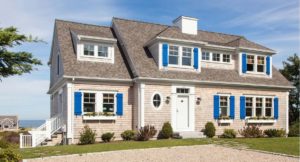
Exterior Painting Color Combinations for the American Craftsman
What it is: Craftsman homes were born out of the Arts and Crafts Movement in the late 1800s, which originated in Britain. It was a movement that rebelled at the rising Industrial Revolution where handwork was favored and emphasized over mass production. When it arrived in America, it became a movement that rejected the over-decorated Victorian houses but distinguished itself as the Craftsman Bungalow where the goal was to provide affordable housing for the middle-class Americans.
The American Craftsman has further spread thanks to Gustav Stickley, founder of The Craftsman magazine, which inspired the style’s name. The magazine contained furniture and house designs of the style including those of the architect brothers, Charles Summer Green and Henry Mather Green who had a Pasadena-based firm and became renowned masters of the style.
Defining Features: The Craftsman home was designed to be sturdy and made of natural materials. It shows great details outside but the inside remains simple with a wide-open layout. The house is often made of mixed materials primarily wooden clapboard and shingle sidings with some stone, bricks, stucco, and concrete block features.
- Low Pitched Gable Roofs – The roofs had different variations: side-gabled, front-gabled, cross-gabled and hipped roof, often decorated with barge boards and sometimes supported by a knee brace or eave bracket which is very typical in Craftsman homes.
- Front Porch – Porches are another distinct feature of Craftsman homes and is rarely built without one. Porches can either be full or partial, sheltered or under a separated, extended roof.
- Tapered Posts – These usually support roofs to form porches and have wood or brick bases.
- Multi-pane windows and Doors – The top tier consists of four or six panes with a single windowpane at the bottom and is usually double-hung windows. Front doors also had partial panes at the top while the bottom and middle of the doors are paneled.
- Exposed Rafters and Beams – The Arts and Crafts movement was all about showing the handiwork and rafters and beams were purposely exposed or added as a decorative touch.
Dominant Colors: Colors are subdued and limited to earthy browns and greens to blend in with the landscape. Contrast colors are limited to the decorative details to help it stand out.
Modern Color Trends:
- Sage green sidings + white trim + burgundy accent – Sage green is a popular color among many homeowners regardless of whether the house style is traditional, modern or contemporary. A common worry of homeowners is that sage might be too common of a color, which is why it’s important to come up with a unique color scheme using sage. The Craftsman house makes this possible because of the many decorative elements in the house. Sage when paired with a darker color, in this case, burgundy, becomes more dramatic.
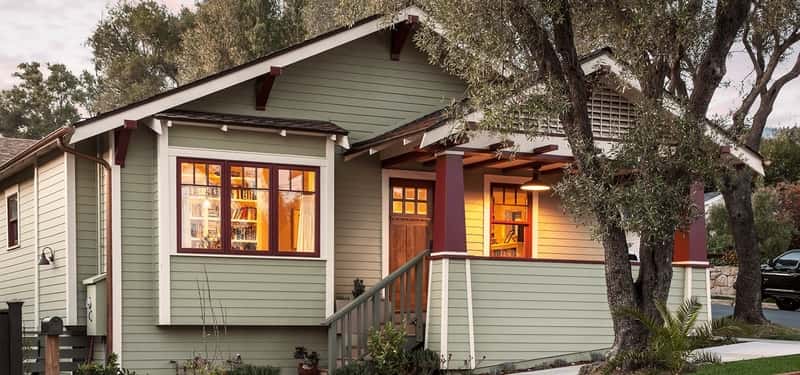
- Slate blue + off-white trim – While navy blue is a well-loved exterior color, slate blue is a slightly lighter and grayish shade of blue that has the same flexibility as navy. It’s not as dark as navy but it plays well with other hues. For a classic and clean look, keep the trims in off-white color.
Ranch Home Color Combinations
What it is: Often called the Rancher or the Rambler House, the ranch-house style can be traced back to the North American Spanish Colonial Architecture in the 17th to the 19th century which was single-storied and perfect for the warm climate. The style boomed after World War II because its ease of construction and affordability were able to provide homes quickly to the rising generation of baby boomers. The style is often considered a subtype of modern architecture and today, most ranch homes are often designed in the modern style.
Defining Features:
- Single Floor and Low-level house— Inspired by the Spanish Colonial houses, the rancher is a single, low structured house.
- Flat or Low-pitched Roof with Large Overhangs – Roofs are built low and had large overhangs to provide additional shade from the sweltering sun.
- Attached Garages – Moving back to the suburbs meant being far from the city and cars were needed to get out and about. Ranch houses integrated the garage into its style to accommodate vehicles.
- Blended Indoor and Outdoor Spaces – Like the Modern house, the Ranch houses placed emphasis on the environment and since the houses were built fairly low, it was easy to walk outside right out of your house.
- Picture Windows and Sliding Glass Doors – Large picture windows are placed on the front for a view while sliding glass doors opened to the back and led to the patio.
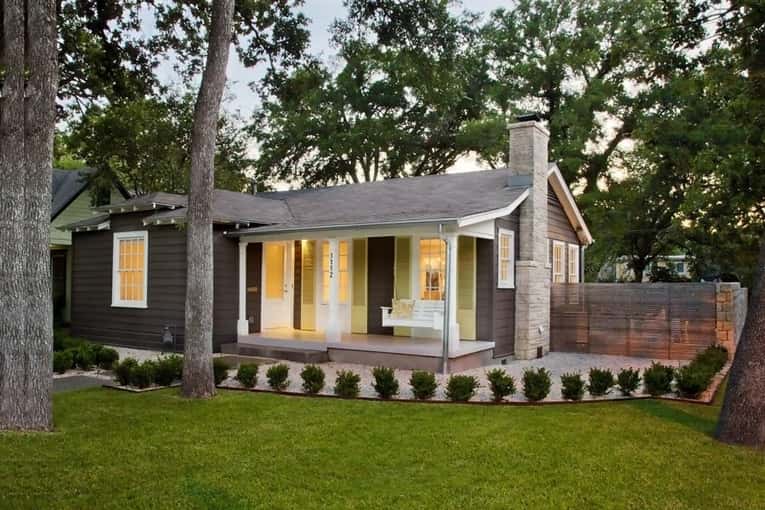
Dominant Colors: Ranch homes used single colors since it was quicker to use a single shade.
Modern Color Trends:
Chocolate Brown + white – Ranch-style houses are monotone by nature, owing to the fact that it made it easier and quicker to construct. Updated styles still continue to use simple hues but are not afraid of color. Chocolate brown is one of those beautiful earth tones that never get boring and it sits right at home with a ranch style house. The addition of the pale yellow accent further enhances the brown. A brown façade will accommodate just about any accent color but keeping the hues soft will make a ranch-style house seem more cozy and warm.
- Off-white + black and tan accents – If you want something clean and simple, you will never go wrong with an off-white color with black and tan accents.
Mid-century Modern
What it is: Headed by the likes of Walter Gropius, Ludwig Mies Van der Rohe, Le Corbusier and many more, Mid-Century Modern or more popularly known as Modern Architecture, came from post-World War II, a time for discovery of new building methods and materials. The style emerged around the early 1930s to 1965 and the modern simplicity remains a well-loved style even amongst millennial homeowners.
Defining Features: Steel and plywood became the main material for houses and there was an emphasis on integration with nature thus the open space plans and wide use of glass that encouraged people to go outside.
- Flat Roof – Modern houses use simple geometric lines where most structures have flat roofs.
- Use of Steel, Glass, and Concrete- Heavy use of glass is a distinct feature of most modern houses to let natural light in. Steel and concrete were new materials during the post-World War II era and were incorporated into modern structures and furniture.
- Connected Outdoor Spaces – In line with their philosophy of encouraging people to be one with the environment, indoor spaces open up to the outdoors.
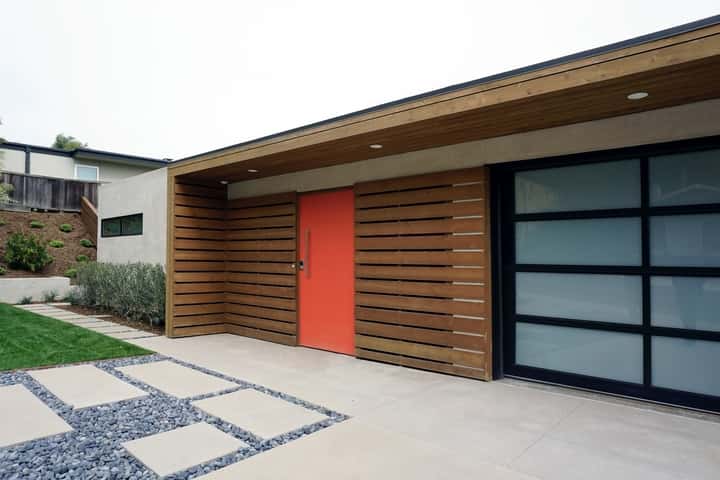
Dominant Colors: Modern homes rely on its natural finishes for its colors but more recent homes use one eye-catching accents for their homes to offset the neutrals.
- Orange + Brown – This duo is a classic Mid-century modern color combination. While orange is typically hard to pair with, brown tones down the vibrancy and brightness of orange, lending warmth and coziness to the house.
- Chartreuse + Gray – Another classic modern combo, this duo just complements each other. The chartreuse color offsets the otherwise dullness of gray.
If you’re looking for Mid-century inspired colors, look at the works of the modern furniture designers like Charles Eames and Eero Saarinen.
Timeless Color Trends
Newer and fresher colors will always be released every single year and as a homeowner, it’s always tempting to keep up with those trends. The good news is that trends in exterior colors tend to last longer than most interior color trends. Even if there are new exterior colors, choose a palette that’s perennial and classic. Being timeless doesn’t mean staying with safe colors. It’s choosing color palettes that have true, staying power.
